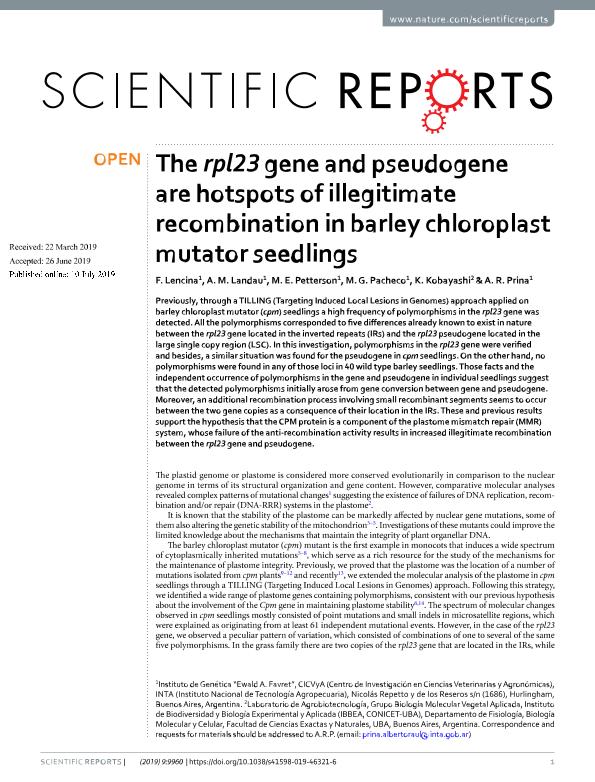Mostrar el registro sencillo del ítem
dc.contributor.author
Lencina, F.
dc.contributor.author
Landau, A. M.
dc.contributor.author
Petterson, M. E.
dc.contributor.author
Pacheco, M. G.
dc.contributor.author
Kobayashi, Ken

dc.contributor.author
Prina, A. R.
dc.date.available
2022-12-14T17:46:12Z
dc.date.issued
2019-07
dc.identifier.citation
Lencina, F.; Landau, A. M.; Petterson, M. E.; Pacheco, M. G.; Kobayashi, Ken; et al.; The rpl23 gene and pseudogene are hotspots of illegitimate recombination in barley chloroplast mutator seedlings; Nature Publishing Group; Scientific Reports; 9; 1; 7-2019; 1-13
dc.identifier.issn
2045-2322
dc.identifier.uri
http://hdl.handle.net/11336/181181
dc.description.abstract
Previously, through a TILLING (Targeting Induced Local Lesions in Genomes) approach applied on barley chloroplast mutator (cpm) seedlings a high frequency of polymorphisms in the rpl23 gene was detected. All the polymorphisms corresponded to five differences already known to exist in nature between the rpl23 gene located in the inverted repeats (IRs) and the rpl23 pseudogene located in the large single copy region (LSC). In this investigation, polymorphisms in the rpl23 gene were verified and besides, a similar situation was found for the pseudogene in cpm seedlings. On the other hand, no polymorphisms were found in any of those loci in 40 wild type barley seedlings. Those facts and the independent occurrence of polymorphisms in the gene and pseudogene in individual seedlings suggest that the detected polymorphisms initially arose from gene conversion between gene and pseudogene. Moreover, an additional recombination process involving small recombinant segments seems to occur between the two gene copies as a consequence of their location in the IRs. These and previous results support the hypothesis that the CPM protein is a component of the plastome mismatch repair (MMR) system, whose failure of the anti-recombination activity results in increased illegitimate recombination between the rpl23 gene and pseudogene.
dc.format
application/pdf
dc.language.iso
eng
dc.publisher
Nature Publishing Group

dc.rights
info:eu-repo/semantics/openAccess
dc.rights.uri
https://creativecommons.org/licenses/by/2.5/ar/
dc.subject
cloroplastos
dc.subject
plastoma
dc.subject
mutador
dc.subject
cebada
dc.subject.classification
Ciencias de las Plantas, Botánica

dc.subject.classification
Ciencias Biológicas

dc.subject.classification
CIENCIAS NATURALES Y EXACTAS

dc.title
The rpl23 gene and pseudogene are hotspots of illegitimate recombination in barley chloroplast mutator seedlings
dc.type
info:eu-repo/semantics/article
dc.type
info:ar-repo/semantics/artículo
dc.type
info:eu-repo/semantics/publishedVersion
dc.date.updated
2020-11-20T14:49:20Z
dc.journal.volume
9
dc.journal.number
1
dc.journal.pagination
1-13
dc.journal.pais
Reino Unido

dc.journal.ciudad
Londres
dc.description.fil
Fil: Lencina, F.. Instituto Nacional de Tecnología Agropecuaria. Centro de Investigación en Ciencias Veterinarias y Agronómicas. Instituto de Genética; Argentina
dc.description.fil
Fil: Landau, A. M.. Instituto Nacional de Tecnología Agropecuaria; Argentina
dc.description.fil
Fil: Petterson, M. E.. Instituto Nacional de Tecnología Agropecuaria. Centro de Investigación en Ciencias Veterinarias y Agronómicas. Instituto de Genética; Argentina
dc.description.fil
Fil: Pacheco, M. G.. Instituto Nacional de Tecnología Agropecuaria. Centro de Investigación en Ciencias Veterinarias y Agronómicas. Instituto de Genética; Argentina
dc.description.fil
Fil: Kobayashi, Ken. Consejo Nacional de Investigaciones Científicas y Técnicas. Oficina de Coordinación Administrativa Ciudad Universitaria. Instituto de Biodiversidad y Biología Experimental y Aplicada. Universidad de Buenos Aires. Facultad de Ciencias Exactas y Naturales. Instituto de Biodiversidad y Biología Experimental y Aplicada; Argentina
dc.description.fil
Fil: Prina, A. R.. Instituto Nacional de Tecnología Agropecuaria. Centro de Investigación en Ciencias Veterinarias y Agronómicas. Instituto de Genética; Argentina
dc.journal.title
Scientific Reports
dc.relation.alternativeid
info:eu-repo/semantics/altIdentifier/url/http://www.nature.com/articles/s41598-019-46321-6
dc.relation.alternativeid
info:eu-repo/semantics/altIdentifier/doi/http://dx.doi.org/10.1038/s41598-019-46321-6
Archivos asociados
